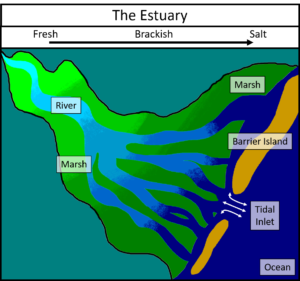LUMCON’S ESTUARINE ENVIRONMENT
LUMCON is located in the Barataria-Terrebonne Estuary, an area bordered by the Mississippi River to the north and east, the Atchafalaya River to the west, and the Gulf of Mexico to the South. Estuaries mark the boundary between the land and the sea; the place where freshwater mixes with the salty ocean. Because it is an area of mixing, the estuary is defined by a gradient of water quality (e.g. temperature, salinity, dissolved gases).

The most landward portion of the estuary receives input from rain, surface runoff, and discharge from lakes and rivers. Water quality in this region is most similar to the water sources that supply it. The plants and animals here are adapted to a freshwater lifestyle and cannot tolerate dissolved salt in their water supply.
As water flows through the estuary, it gradually mixes with saltier water moving in from the ocean. Thus, as you move from the land to the sea, water quality steadily changes until it matches that of the open ocean. At the most oceanward end of the estuary, the plants and animals are adapted to life in saltwater.
In the estuary, you will encounter water quality characteristics that fall in between freshwater and saltwater. Estuaries are also unique because tidal forces influence them. Tides are the regular rise and fall of water in the ocean caused by the gravitational pull of the sun and moon. At high tide, the ocean pushes into the estuary and saltwater moves closer to the land. At low tide, the estuary drains and the ocean is pushed back to be replaced by freshwater flowing from the land. These regular movements of ocean water into and out of the estuary cause the salinity at any given location within the estuary to continually change. Estuarine organisms, therefore, must be able to tolerate a variety of water quality conditions.
In addition to the tides, other natural disturbances can affect how far saltwater moves up the estuary. For example, heavy rains upstream from the estuary will increase the flow of freshwater into the estuary and push the saltier water further towards the ocean. In contrast, during drought conditions, freshwater flow is diminished and saltwater can push very far inland. In fact, during the drought of 1999-2000, saltwater was detected as far inland as Houma. Human activities can also affect the progression of saltwater into the estuary. For instance, the dredging of canals for navigation or petroleum exploration (pipeline canals) gives saltwater a direct route inland. Because these canals are usually deeper than natural bayous, saltwater, which is heavier than freshwater, slowly moves inland along the bottom of the canal. This “saltwater intrusion” is a primary cause for the death of freshwater plants such as our native cypress.
